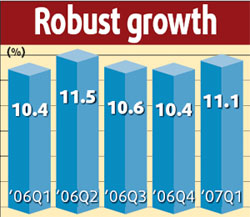| Home / Business / News | Tools: Save | Print | E-mail | Most Read | Comment |
| Trade Surplus Growth Set to Slow |
| Adjust font size: |
Growth in The surplus soared to US$112.5 billion in the first half of this year, up 84 percent from a year earlier. The June surplus hit a record US$26.9 billion. The remarkable increase resulted partly from enterprises rushing to export as much as they could ahead of July 1, when the value-added tax rebate was either scrapped or reduced as part of efforts to trim the surplus, Ministry of Commerce spokesman Wang Xinpei said. "This factor (the export rush) will fade out in the second half of this year," Wang said. In addition, other measures to curb exports will help slow the growth in surplus, he added. The government has adopted various methods to narrow the surplus, such as levying export taxes and encouraging imports of high-tech products. However, many economists predict it will take time before a significant change can be seen. "We have to wait at least three months to see any effect, and possibly longer, since many firms will continue to manufacture and export given their capacity is already in place," said Stephen Green, an economist with Standard Chartered Bank in "We do not expect to see any major change in the overall picture in the near future as the dampening effect of the tax rebate adjustment is likely to be offset by stronger global industrial production momentum," said Liang Hong, an economist with Goldman Sachs' Asia Economics Research Group. In another development, technical barriers erected by trade partners cost China as much as US$75.8 billion last year and over 15 percent of exporters were affected, according to research by the Ministry of Commerce. The barriers refer to regulations, standards or procedures for assessing imports. Compared to traditional trade barriers such as tariff and import quotas, they have been adopted more frequently in recent years. (
|
| Tools: Save | Print | E-mail | Most Read |
| Comment |
 |
| Related Stories |
|
|
